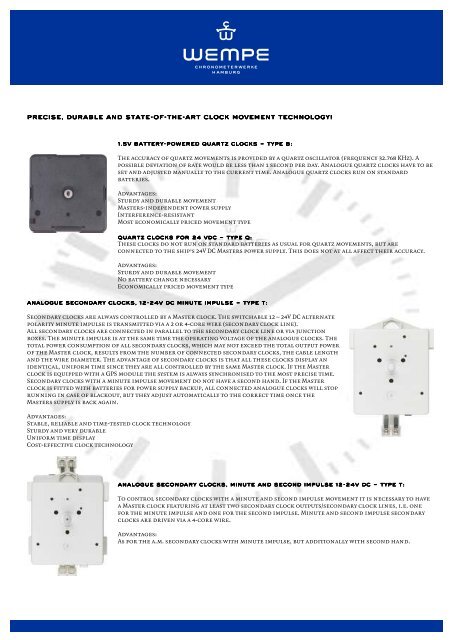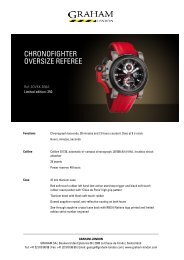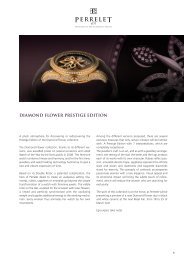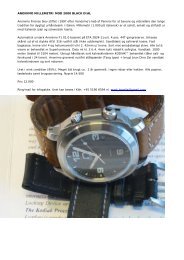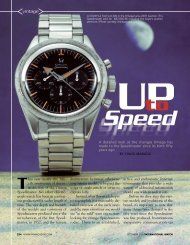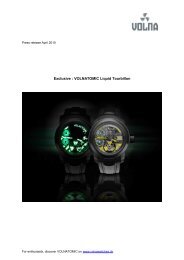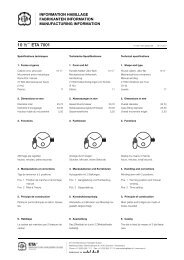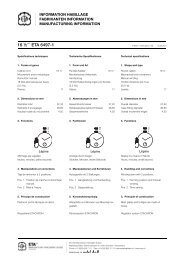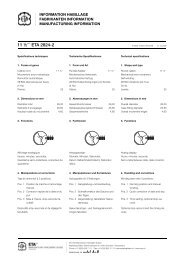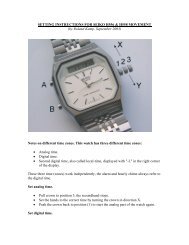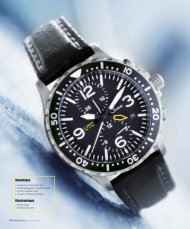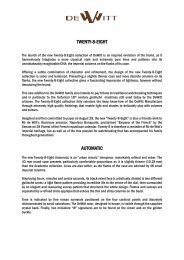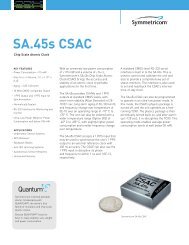Catalogue WEMPE Marine clock - Ship's time systems 2010-2011 ...
Catalogue WEMPE Marine clock - Ship's time systems 2010-2011 ...
Catalogue WEMPE Marine clock - Ship's time systems 2010-2011 ...
You also want an ePaper? Increase the reach of your titles
YUMPU automatically turns print PDFs into web optimized ePapers that Google loves.
Precise, Precise, durable durable and and state state-of state of of-the of the the-art the art <strong>clock</strong> lock movement technology!<br />
1.5V 1.5V battery battery-powered battery battery powered quartz <strong>clock</strong>s <strong>clock</strong>s – Type BB:<br />
B<br />
The accuracy of quartz movements is provided by a quartz oscillator (frequency 32.768 KHz). A<br />
possible deviation of rate would be less than 1 second per day. Analogue quartz <strong>clock</strong>s have to be<br />
set and adjusted manually to the current <strong>time</strong>. Analogue quartz <strong>clock</strong>s run on standard<br />
batteries.<br />
Advantages:<br />
Sturdy and durable movement<br />
Masters-independent power supply<br />
Interference-resistant<br />
Most economically priced movement type<br />
quartz quartz <strong>clock</strong>s <strong>clock</strong>s for for 24 24 VDC VDC – Type Q:<br />
These <strong>clock</strong>s do not run on standard batteries as usual for quartz movements, but are<br />
connected to the ship’s 24V DC Masters power supply. This does not at all affect their accuracy.<br />
Advantages:<br />
Sturdy and durable movement<br />
No battery change necessary<br />
Economically priced movement type<br />
Analogue Analogue Analogue secondary secondary <strong>clock</strong>s, <strong>clock</strong>s, 12 12-24V 12 24V DC minute impulse – Type TT:<br />
T<br />
Secondary <strong>clock</strong>s are always controlled by a Master <strong>clock</strong>. The switchable 12 – 24V DC alternate<br />
polarity minute impulse is transmitted via a 2 or 4-core wire (secondary <strong>clock</strong> line).<br />
All secondary <strong>clock</strong>s are connected in parallel to the secondary <strong>clock</strong> line or via junction<br />
boxes. The minute impulse is at the same <strong>time</strong> the operating voltage of the analogue <strong>clock</strong>s. The<br />
total power consumption of all secondary <strong>clock</strong>s, which may not exceed the total output power<br />
of the Master <strong>clock</strong>, results from the number of connected secondary <strong>clock</strong>s, the cable length<br />
and the wire diameter. The advantage of secondary <strong>clock</strong>s is that all these <strong>clock</strong>s display an<br />
identical, uniform <strong>time</strong> since they are all controlled by the same Master <strong>clock</strong>. If the Master<br />
<strong>clock</strong> is equipped with a GPS module the system is always synchronised to the most precise <strong>time</strong>.<br />
Secondary <strong>clock</strong>s with a minute impulse movement do not have a second hand. If the Master<br />
<strong>clock</strong> is fitted with batteries for power supply backup, all connected analogue <strong>clock</strong>s will stop<br />
running in case of blackout, but they adjust automatically to the correct <strong>time</strong> once the<br />
Masters supply is back again.<br />
Advantages:<br />
Stable, reliable and <strong>time</strong>-tested <strong>clock</strong> technology<br />
Sturdy and very durable<br />
Uniform <strong>time</strong> display<br />
Cost-effective <strong>clock</strong> technology<br />
Analogue Analogue secondary secondary <strong>clock</strong>s, <strong>clock</strong>s, minute minute and and second second impulse impulse 12-24V 12<br />
24V DC DC DC – Type Type TT:<br />
T<br />
To control secondary <strong>clock</strong>s with a minute and second impulse movement it is necessary to have<br />
a Master <strong>clock</strong> featuring at least two secondary <strong>clock</strong> outputs/secondary <strong>clock</strong> lines, i.e. one<br />
for the minute impulse and one for the second impulse. Minute and second impulse secondary<br />
<strong>clock</strong>s are driven via a 4-core wire.<br />
Advantages:<br />
As for the a.m. secondary <strong>clock</strong>s with minute impulse, but additionally with second hand.


